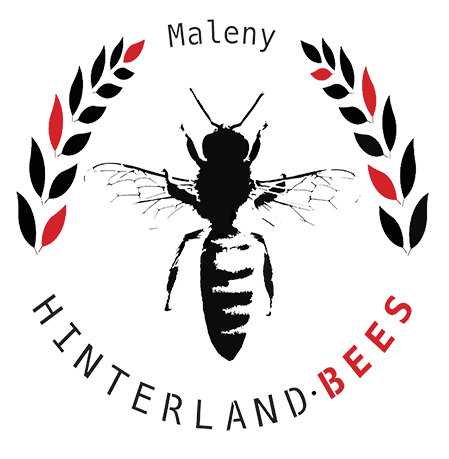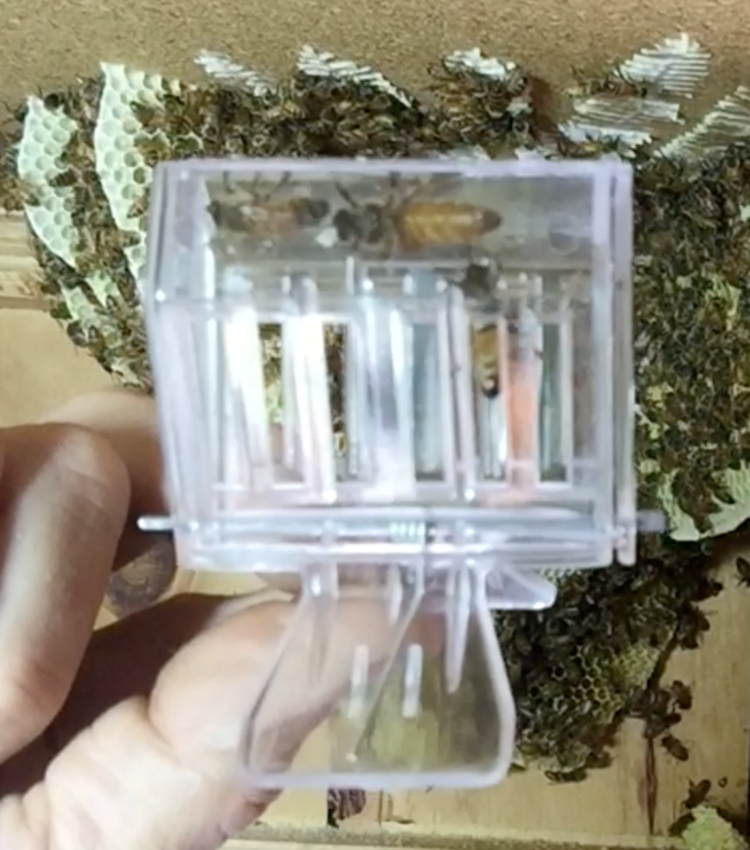How to Catch a Swarm
Simple, catch the Queen
Without a doubt the most important guarantee of successful swarm capture is to catch the queen. Catch the queen and you catch the swarm.
But let’s backtrack as there are few things to do before you get to the queen.
Queen in a queen-clip
Queen-Clip
For starters you will need a queen-clip, a small hair clip-like device used to cage the queen with gaps big enough for worker bees to get in to feed and groom her but gaps too small for her to escape. These are available from most beekeeping suppliers and only cost a few dollars. It’s always good to get a few, I’m not the only one to have trodden on one in all of the excitement of the swarm catch, or lost one in the process of climbing a tree to get to a swarm. Make sure you have at least one backup!
You might also want to have your smoker lit and on hand. This is only in case of an emergency, your smoker is NOT used in catching a swarm. DO NOT smoke a swarm.
It’s important to know that a swarm of bees is generally very gentle. Bees in Australia are not known to be aggressive, however they can be defensive. They will defend their home from anything they perceive to be a threat and some colonies will do this with a lot more vigour than others. A swarm is by contrast, homeless (or on their way to a new home) and therefore have nothing to defend and as a result tend to be quite docile.
There are a few methods used for catching a swarm including shaking them straight into the box, scooping them off a structure into the box or cutting a branch and lowering that into the box. But even if you get that swarm in the box, if the queen or the colony decides that they don’t like the new home on offer, there is no guarantee that they will hang around. This is why I think catching the queen is central to success.
So, how do you go about catching the queen?
My favourite method, I call The White Sheet Method, is to shake the whole swarm onto a white sheet and make them march up into the catch-box (usually a standard or nucleus hive). As they spread out, I start looking for the queen.
The White Sheet Method
Making the colony march like this is a bit like a magic trick and is just as awesome as seeing the airborne swarm. I’m not sure why, but bees will always walk up hill in this situation, so it’s important to have the catch-box elevated. I often drape the white sheet over a milk crate and mount the catch-box on the crate. This method can be just as effective using the slope of the ground if it is steep enough.
Once you have your catch-box and sheet setup, it’s time to get the swarm onto the sheet. Depending on the situation, you might be able to setup the sheet and catch-box directly under the swarm and shake them straight down onto the sheet. I wouldn’t recommend doing this if the swarm is more than 180cm off the ground and it is important that there are no obstacles so that it is a straight drop onto the sheet.
If the swarm is on a branch and this is small enough to cut, you can then carry the branch and all to the white sheet. Alternatively, you may need to shake or scoop the swarm into a bucket before tipping them out and onto the sheet. What ever method is used, it’s important to try to get the entire population of the swam onto the sheet as efficiently as possible.
Think about were the queen might be. Remember she landed first and the rest of the swarm clustered around her, so she is very likely in the centre of the cluster, possibly still clinging to the branch or structure, especially if the swarm has only just landed. Take extra care if you need to scoop the swarm, and if you are shaking them, make sure you shake every last one as the queen might well be in those last few on the branch.
Once you have all of the bees on the sheet they will start spreading out quite quickly. Some will already be heading up hill and into the box. Others will take a little time to orientate and start heading that way. Make sure you have your queen clip in hand, this is the time to start search for the queen.
Begin looking closest to the catch-box as you don’t want her walking inside before you can cage her. Then start scanning further out. Concentrate and try not to panic, they are all on the move but it’s amazing how obvious the queen will be when you finally spot her - don’t give up! I find that she tends to move a little differently than the other bees, with a bit of a waddle, quite often with her wings spread out a little, almost like she is trying to keep her balance. Finally, don’t forget that there are likely to be drones in amongst the swarm which can be a bit distracting as they are always a similar size to the queen.
Once you spot her, try not to get her in the clip too quickly because you don’t want to damage her. Watch her closely and gently try to get the clip around her without getting her caught in any of the moving parts. You will probably end up with extra bees inside the clip too, don’t worry about them as they can get out. I find its best to keep scanning the spot were you caged her, just in case she slipped out. Do this for a few seconds before you look into the clip to make sure she is in there. If she is, congratulations, you have captured the swarm!
Now you can place the queen clip inside the catch-box and you can be confident that all of the other bees will move in to join her. Another word of warning here, the queen-clip can easily be open with the slightest bump and the queen can escape in a flash. Don’t carry it by the two wings used to open it and if you can, put a small rubber band around it to prevent it opening accidentally.
I usually place the queen-clip between the two central frames inside the catch box. If you are using a temporary catch-box, like a cardboard box with no frames, attach the queen-clip to a twiggy branch and put that inside the box (this will also give the rest of the swarm something to cling to and spread out so they don’t over heat). To hasten the process, scoop some of the bees onto of the queen so they know were she is. They will immediately start fanning their Nasonov glands to alert the rest of the swarm to the location of the queen. This will create a domino-effect with more and more bees releasing the beautiful lemon grass scent of Nasonov pheromone. From here the rest of the swarm will start to rapidly move into the box.
It’s best to wait until night fall to move the catch-box to its permanent new home. Once in place, I generally leave the queen inside the queen-clip for at least 72 hours. This will give the colony time to start building comb and put down their roots and they are highly unlikely to abscond.
The bonus to come out of a swarm is that they are generally in comb building mode and will draw out many frames of foundation within a week or so. I usually help them out by giving them all the sugar syrup they can consume during this period, usually about 10 litres in the first 7 days. I should note here that I only ever feed sugar syrup to swarms and I do it inside the hive so that it can not be accessed by other colonies with the risk of spreading disease or adulterating their honey.
Like every aspect of beekeeping there are multiple opinions and I’m sure every beekeeper will have a different method for catching swarms, but its hard to argue that the white-sheet method doesn’t add a bit of extra theatre to the process, another reason why I love to use this method.
Every day is a learning experience, so here is just one more thing to be aware of: A swarm can have more than one queen - and that can complicate matters, so I’ll leave that for another post.

